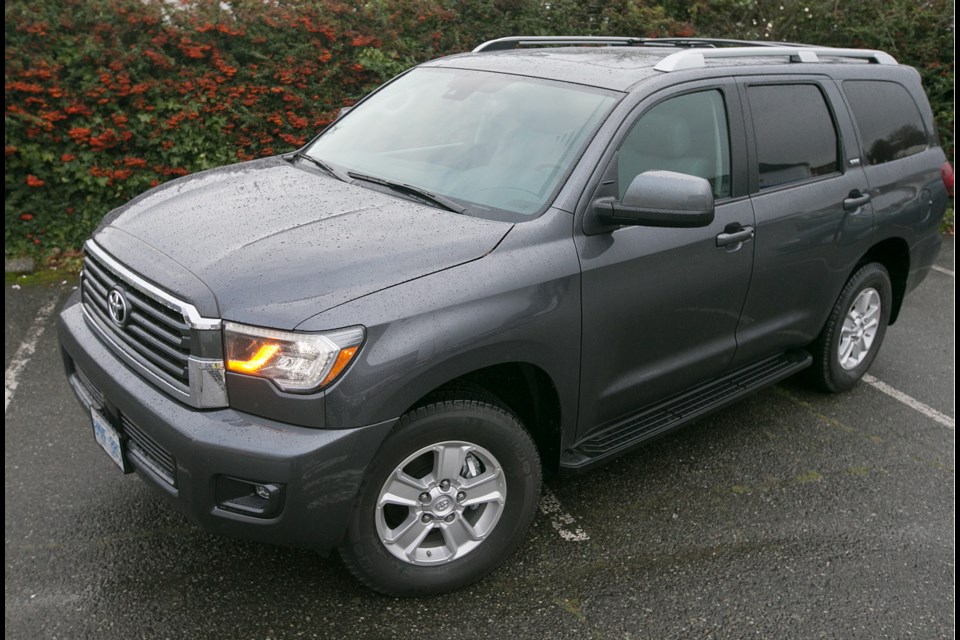In an ever-shrinking world, the 2018 Toyota Sequoia is the beacon of hope for those who shop in the big and tall section of the clothing store.
Everything is shrinking these days, and vehicles are no exception. Manufacturers are making more smaller and lighter vehicles that use less fuel.
The mid-sized segment of the industry is booming, because it fits the widest percentage of the population. Most adults can fit comfortably in the front seats of a mid-sized vehicle. But don’t expect space to be as generous for rear passengers unfortunate enough to be seated behind a person with long legs.
The full-sized Sequoia is the automotive solution, with room for eight occupants, five of them enjoying more than generous leg- and headroom.
Essentially a Toyota Tundra truck with a body, the Sequoia is one of the few SUVs with body-on-frame construction (as opposed to unibody).
The SUV takes its name from the sequoia, a large tree that is found — albeit rarely — even on the Island. Like its namesake, the Toyota Sequoia is large, the biggest vehicle in Toyota’s lineup.
For its 10th birthday, Toyota gave the 2018 Sequoia some new clothes, but it essentially is the same vehicle as it was a decade ago.
In 2018, the Sequoia is offered in three trim models, starting with the SR5 with a base price of $60,190.
I drove one such model, which comes standard with a 5.7-litre V-8, six-speed automatic transmission and part-time four-wheel drive.
I haven’t driven a V-8-equipped vehicle in a while. Some competitors, such as the Ford Expedition, now come equipped with a turbocharged V-6 instead.
The engine produces 381 horsepower and 401 foot-pounds of torque — enough power to tow up to 3,220 kilograms (7,100 lbs.), making it an obvious choice to pull a motorhome or a large boat.
The Sequoia holds its own carrying cargo as well, capable of carrying between 535 and 3,400 litres behind the front seats.
While powerful, the engine is also the Sequoia’s Achilles heel, with a 18.4 litres per 100 kilometres fuel-economy rating for the city and 13.8 on the highway. Because of its high consumption, buyers have to pay a $2,000 federal government green levy — the only Toyota slapped with this penalty. The Nissan Armada, which has a 5.6-litre V-8 under its hood, has a $1,000 green levy by comparison.
The engine also produces an estimated 7,640 kilograms of CO2 emissions a year, which is higher than competitors the Armada, Ford Expedition or Chevrolet Tahoe.
Some of that consumption can be attributed to the Sequoia’s 2,707-kilogram curb weight, which makes it the heaviest of the small group assembled here.
The weight does have a silver lining — it contributes to a very comfortable and controlled ride. Coupled with low wind and tire noise, the Sequoia is in its element on the highway, with or without a load.
The wide and comfortable front seats reinforce the idea of long-haul bliss, especially for those with a larger girth.
The cabin is simple and functional, without the embellishment that is becoming more common on crossovers. The instrument panel included two gauges I haven’t seen in a very long time — one for oil temperature and an ammeter.
The SR5 is the base model, and it shows. While well put together, the interior features a lot of hard plastic, making the SUV feel more like a work truck than a family vehicle.
Apart from the ridiculously small knob for the audio system, the rest of the knobs, switches, dials — even the steering wheel — were sized for larger, or gloved, hands.
When Toyota refreshed a number of items in recognition of the Sequoia’s 10th birthday, somebody forgot the infotainment system, or didn’t think it important enough.
The media interface, with its 6.1-inch screen, might have been state-of-the-art 10 years ago, but now lags far behind its rivals. It performs the basic functions, but is not intuitive to operate. For example, I had to refer to the owner’s manual to link my phone, perhaps the first time I have had to do so in years.
Neither Apple CarPlay nor Android Auto is available. With a list price of more than $60,000, the oversight is disappointing.
My tester came with a smattering of active safety features, including a pre-collision warning system, lane-departure alert with steering assist and blind-spot monitoring with rear cross-traffic alert.
The Sequoia is a natural choice for those looking for an a full-size SUV, with more than generous room and a surprisingly comfortable ride. It is also a tough and capable off-roader. But a thirsty engine and a dated technology suite keep it from reaching the top of the segment.
THE SPEC SHEET
Type: Full-sized SUV, front engine, four-wheel-drive
Engine: 5.7-litre V-8, 381 hp at 5,600 r.p.m., 401 lb.-ft. of torque at 3,600 r.p.m.
Transmission: Six-speed automatic
Dimensions (mm): Length, 5,210; width, 2,030; height, 1,995; wheelbase, 3,100
Curb weight (kg): 2,707
Tow capacity (kg): 3,220
Price (base/as tested): $60,190/ $64,075 (includes $1,785 freight, $2,000 Green levy and PDI and $100 AC tax)
Options: Nil
Tires: 275/65 R18 on alloy wheels
Fuel type: Regular
Fuel economy (L/100km): 18.4 city/ 13.8 highway
Warranty: Three years/60,000 km new car, five years/100,000 km powertrain and roadside assistance



